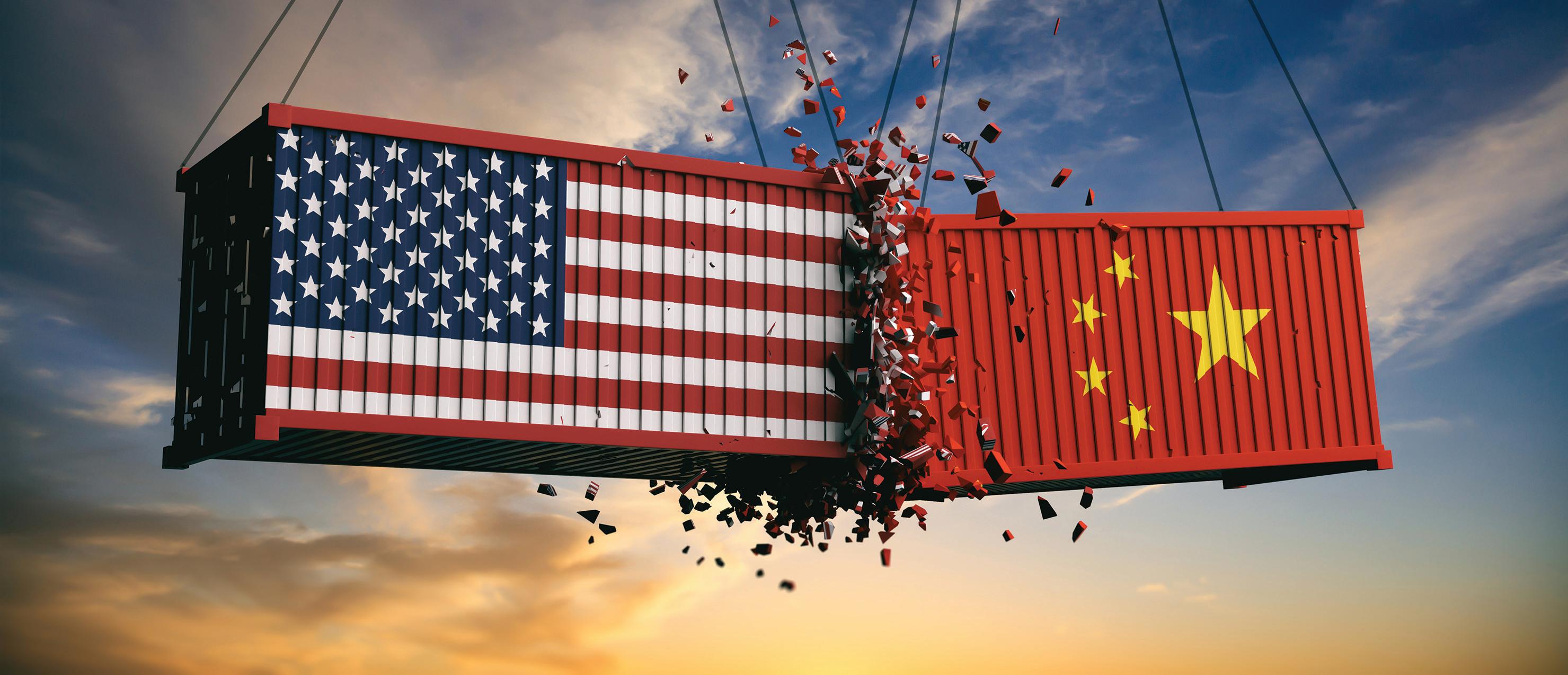
7 minute read
WTariffs, Trade, and Textiles Navigating U.S. Trade Policy in a Shifting Global Landscape
By Wes Fisher, Director of Government Affairs, INDA
hat was once the domain of trade lawyers and procurement officers is now a concern for the boardroom. U.S. trade and tariff policy is evolving into a complex mixture of economic competition, national security, and concerns about forced labor, not to mention the unpredictable nature of President Donald Trump's decision-making process. For the fiber, nonwovens, and broader textile industries, the implications are profound.
When President Trump announced plans to implement reciprocal tariff rates on dozens of countries with a 10% minimum baseline in early April, nearly every industry had questions and concerns around the long-term impacts of these tariffs. Meanwhile, the U.S. courts have grappled with whether the President has the authority to implement such tariffs under emergency powers laws. Furthermore, the debate over which courts have jurisdiction over the matter complicates matters. The key takeaway is that U.S. trade policy is no longer guided solely by economic efficiency or multilateral rules. Instead, it is increasingly being shaped by national security, industrial strategy, and human rights enforcement. For producers and buyers of fibers, nonwovens, and textile inputs, this shift demands constant vigilance, strategic realignment, and a clear-eyed view of what lies ahead.
From Free Trade to Strategic Trade
For decades, U.S. trade policy operated under a broadly bipartisan commitment to multilateral liberalization, with the World Trade Organization (WTO), Most Favored Nation (MFN) principles, and regional trade deals like NAFTA guiding the rules of the road. But that framework began to erode during the Trump administration with the introduction of Section 301 tariffs on China – part of a broader strategy to pressure Beijing on intellectual property theft, forced technology transfer, and industrial subsidies. While President Biden softened the rhetoric during his term in office, he largely preserved and even built upon many of these tools established during the first Trump administration. Section 301 tariffs remained in place during his term, yet the Biden administration extended exclusions to these tariffs. However, the Biden administration also went about sunsetting approximately half of the exclusions to Section 301 tariffs on China. It pursued subsidies and tax credits for U.S.-based manufacturing through legislation such as the Inflation Reduction Act (IRA) and CHIPS Act, signaling a broader move toward “managed trade” and domestic industrial policy.
For the fiber and nonwovens sectors, which are profoundly globalized and rely on price-sensitive supply chains, this evolving framework presents both risks and opportunities. With Donald Trump’s return to the presidency in 2025, many observers expected him to adopt a far more aggressive position on trade and tariffs than he did during his first term, and he certainly lived up to those expectations, making tariffs among the most discussed topics in public policy.
“Liberation Day” Reciprocal Tariffs Under IEEPA
On April 2, 2025, a date that was dubbed “Liberation Day” in the weeks leading up to a major trade announcement, President Trump issued a sweeping executive order (EO 14257), declaring a national trade emergency and invoking the International Emergency Economic Powers Act (IEEPA) to impose a 10 % universal tariff on imports from nearly all nations, followed by countryspecific reciprocal tariffs – ranging up to 50 % on dozens of major trading partners with whom the U.S. runs large deficits according to the Administration's calculations. These were layered on top of existing Section 301 China duties and Section 232 steel and aluminum tariffs, as well as IEPPA-related tariffs on China, Canada, and Mexico that Trump had implemented weeks prior.
This action led to an escalation with China, pushing tariff rates as high as 145% before settling at a 30% baseline tariff rate on China (in addition to underlying Section 301 duties) at the time of writing this article. While temporarily lowered to 10% for all countries during negotiations, with the UK and China achieving partial agreements, the IEEPA reciprocal tariff rates remain in effect pending a legal resolution and continued negotiations.
On May 28, 2025, the U.S. Court of International Trade ruled that the use of IEEPA to impose tariffs was unconstitutional, deeming the move to be beyond the scope of emergency powers and lacking congressional authorization. The case was then sent to the U.S. Court of Appeals for the Federal Circuit for appeal, which issued a short-term stay, allowing the tariffs to continue. As they deliberate, oral arguments are scheduled for July 31, with a decision expected in August – about three weeks after the pause on higher rates is currently set to end on July 9.
Simultaneously, the U.S. District Court for the District of Columbia has asserted that the Court of International Trade does not have jurisdiction in this matter. Ultimately, it may take a Supreme Court ruling to untangle the legal web of IEEPA.
The Current Tariff Landscape: Fiber and Nonwovens in the Crosshairs
Amid uncertainty around tariff actions initiated by the Trump administration, Section 301 Tariff Rates, and exclusions to those tariffs, which still exclude a handful of products in the nonwovens sector (and have been further extended to August 31, 2025), remain top of mind. These tariffs have pushed the baseline tariff rate on China from 30% (instituted by Trump under IEEPA) to 55% on many products after a 25% section 301 duty is applied. Members of the nonwovens supply chain hold a variety of views on Section 301 tariffs.
For industry, many categories are affected. These include synthetic staple fibers, spun yarns, and various categories of nonwoven roll goods and converting machinery. Even where specific tariff lines have seen exclusions or reductions, the uncertainty surrounding future reviews creates planning challenges.
Beyond Section 301, other trade tools continue to have ripple effects. The Section 232 tariffs on steel and aluminum, for example, have raised costs for machinery and equipment manufacturers. Meanwhile, the lapse of the Generalized System of Preferences (GSP) and the Miscellaneous Tariff Bill (MTB) in 2020 means that inputs from developing countries like India, Indonesia, and the Philippines – historically key sources of certain fibers and resins and products that have no domestic production, like viscose – are subject to MFN duties again, adding costs across the supply chain.
INDA has urged the Trump administration to exclude viscose staple fiber from any new tariffs, given its critical need in many hygiene applications and the lack of U.S. manufacturing. Additionally, antidumping (AD) and countervailing duty (CVD) investigations have directly affected fiber materials. Recent cases targeting polyester staple fiber imports from South Korea, Taiwan, and China have led to additional duties, sometimes exceeding 50%. These trade remedies are often initiated by U.S. industry petitioners and carry long-term consequences for importers of inputs.
Forced Labor Enforcement and Supply Chain Scrutiny
Another recent development in trade enforcement is the rise of human rights as a core trade compliance issue – specifically, the implementation of the Uyghur Forced Labor Prevention Act (UFLPA), signed previously by former President Biden and took effect in mid-2022.
The UFLPA creates a rebuttable presumption that any goods made wholly or in part in China’s Xinjiang Uyghur Autonomous Region are produced with forced labor, and therefore banned from entry into the U.S. Customs and Border Protection (CBP) has significantly ramped up enforcement, detaining shipments of cotton, apparel, and other components like viscose and lyocell.
While the primary focus has been on finished garments and cotton-based goods, nonwovens made with potentially contaminated feedstocks – such as viscose derived from wood pulp processed in suspect regions – are not immune. The law's broad scope and the difficulty of proving clean supply chains mean that industry members need to be aware of their supply chains to ensure compliance.
Manufacturers must now maintain robust documentation and chain-of-custody tracking for raw materials. Even suppliers outside of China may face detentions if any part of their input stream is linked to Xinjiang. Trade compliance teams must be equipped to handle CBP inquiries and leverage third-party traceability tools.
Nearshoring and the Promise –and Pitfalls – of Regional Trade
In response to the twin pressures of tariffs and forced labor enforcement, among other factors, many companies in the textile and fiber sectors are exploring nearshoring and regionalization strategies. Free trade agreements, such as the U.S.-Mexico-Canada Agreement (USMCA) and the Central America-Dominican Republic Free Trade Agreement (CAFTA-DR), offer tariff-free access for qualifying goods and preferential treatment for apparel and yarn inputs.
These agreements have driven significant investment in Mexico, Honduras, and El Salvador, particularly in spinning, knitting, and dyeing capacity. For U.S. nonwovens and fiber producers, this creates potential demand for inputs that can meet regional content requirements. While the tariff landscape is changing rapidly, Mexico is in a particularly favorable position given the exemption of additional IEEPA tariffs (aside from the baseline 10%) for USMCA-qualified products.
However, rules of origin remain a sticking point. Under USMCA, for example, synthetic fibers and yarns must often be sourced from within the region to qualify for duty-free treatment – a challenge for companies reliant on Asian suppliers. Customs documentation, compliance audits, and delays at land ports of entry also complicate regional logistics.
Nonetheless, these agreements provide a foundation for resilient supply chains – especially in categories like hygiene products, industrial textiles, and medical disposables – if companies are willing to invest in upstream capacity and regional partnerships.
Conclusion: Trade Policy as Strategic Imperative
The era of passive trade policy is over. The U.S. government is deploying tariffs, sanctions, and trade enforcement tools not only as levers of economic policy but also as instruments of national security, industrial strategy, human rights enforcement, and as a means to achieve the President's economic policy agenda. For the fiber and nonwovens industry, this reorientation demands far more than regulatory compliance. It requires constant monitoring of trade policy developments, engagement with legal and political processes, and strategic adaptation across sourcing, manufacturing, and logistics.
Tariffs now operate as both economic barriers and political signals, applied unpredictably under frameworks like IEEPA or revived Section 301 authority. Simultaneously, statutory regimes like the Uyghur Forced Labor Prevention Act have introduced human rights enforcement as a material trade risk. Even as nearshoring and regional agreements like USMCA and CAFTA-DR offer partial relief, they come with complex origin requirements and new documentation burdens.
Future presidents, regardless of party, could continue this trend in utilizing the executive's incredibly broad tariff-making authority to accomplish policy goals on topics ranging from economics to the environment.
For companies operating in this environment, success depends on integrating trade policy into core business strategy. Trade compliance is no longer a back-office function – it's a boardroom issue. The most resilient firms will not merely react to these shifts but will position themselves to influence, anticipate, and adapt to a global trade landscape being reshaped in real time.
Wes Fisher is the Director of Government Affairs at INDA, Association of the Nonwoven Fabrics Industry. Reach him at wfisher@inda.org.














